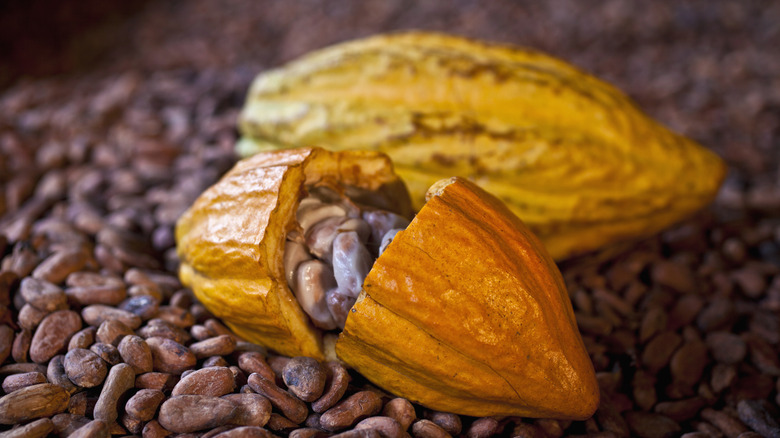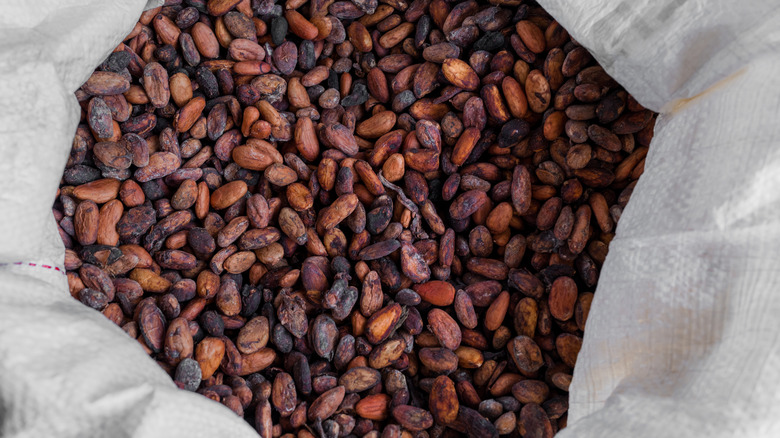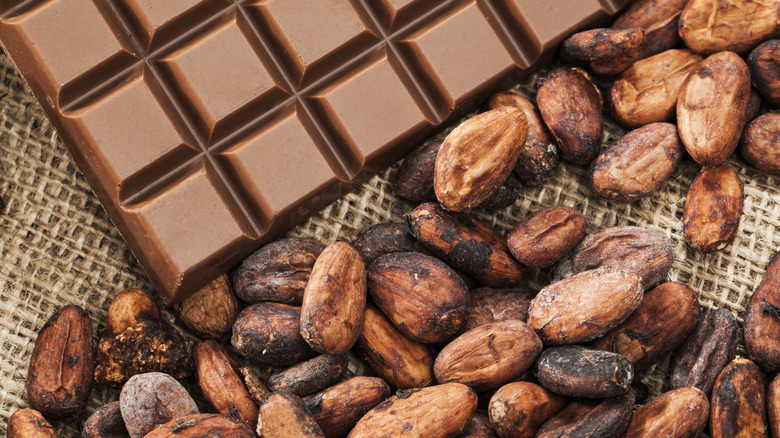Why You Should Think Twice Before Eating Raw Cacao Beans
When you hear "cacao," your mind probably jumps to decadent chocolate desserts or velvety cups of hot cocoa. But before cacao becomes the sweet treat we know and love, it starts as a tough little pod filled with raw beans — and with that, comes the bitter truth about cacao. Here's the kicker: Eating those beans straight from the pod can actually be dangerous (and not very tasty). That's right, your chocolate dreams will come with a bitter twist if you decide to skip the refining process. While raw cacao is technically edible, it's packed with compounds that can make your stomach churn and your taste buds revolt.
Raw cacao beans are loaded with theobromine, a chemical similar to caffeine that can cause everything from jitters to an upset stomach when consumed in large amounts. Plus, their tough, bitter mouthfeel is miles away from the smooth, sweet chocolate we're all used to enjoying. So before you start imagining cacao pods as the next health-food trend, it's worth understanding what makes these raw beans a no-go.
Why raw cacao is no snack
The science behind raw cacao's unappetizing reality comes down to its chemical makeup. Theobromine, found in high concentrations in raw cacao, is a stimulant that can lead to side effects like nausea, headaches, and increased heart rate if consumed in large quantities. While a moderate amount of theobromine is perfectly safe (it's no small part of why chocolate gives you that delightful energy boost), the raw version hasn't undergone the fermentation and roasting processes that help mellow its intensity.
Additionally, raw cacao beans are naturally coated in phytic acid, an anti-nutrient (it blocks your body's ability to absorb nutrients like calcium and zinc). Without processing, this compound remains intact, making raw beans less nutritionally beneficial than their roasted counterparts (anti-nutrients are perfectly safe to eat, by the way).
And let's not forget taste. Raw cacao is intensely bitter, with none of the sweetness or creaminess associated with chocolate. Another risk in eating raw cacao beans is cadmium, which are particularly high in cacao grown in regions like Ecuador and Peru. Levels of Cadmium may be influenced by soil properties, agricultural practices, and natural factors like volcanic activity.
For your safety (and your palate), processed cacao is the way to go even if you do prefer darker, low sugar options. Whether you're savoring a bar of special ruby chocolate or whipping up a decadent cup of hot cocoa, let the experts handle the beans so you can focus on indulging in the flavor.
From bean to bar: how processing saves the day
The transformation of cacao from bitter bean to delicious chocolate involves several crucial steps. First, the beans are fermented, a process that reduces their bitterness and develops the complex flavors we associate with chocolate. Next, they're roasted, which further mellows their intense theobromine levels and neutralizes phytic acid. Finally, the beans are ground into a paste, mixed with sugar and other ingredients and transformed into chocolate products like bars, powders, and spreads.
This is why your store-bought hot cocoa mix tastes so good, it's gone through rigorous refining to remove any harsh or harmful elements. Whether you're sipping on a luxurious hot chocolate recipe or exploring the unique flavor of ruby chocolate, processed cacao offers a safer, tastier experience. So while cacao pods may look tempting in their natural state, it's best to leave the raw beans to the professionals and enjoy chocolate the way it's meant to be: rich, sweet, and utterly irresistible.


